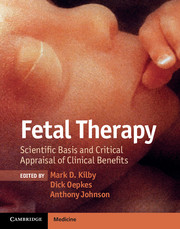
- Publisher:
- Cambridge University Press
- Online publication date:
- February 2013
- Print publication year:
- 2012
- Online ISBN:
- 9780511997778
Last updated 10th July 2024: Online ordering is currently unavailable due to technical issues. We apologise for any delays responding to customers while we resolve this. For further updates please visit our website https://www.cambridge.org/news-and-insights/technical-incident


Fetal treatment, particularly complex fetal therapy, is an emergent and expanding field. This comprehensive text focuses on areas of fetal disease and pathophysiology that can be treated in utero and the benefits and problems with such therapy. Both medical (non-invasive) and surgical procedures are discussed, drawing on the expertise of an internationally renowned author team. Each chapter includes a comprehensive overview of the basic science underlying fetal pathology, as well as discussing the highest level of technical performance of fetal interventions. Contributions from fetal therapy 'centers-of-excellence' around the world collectively emphasize the need for an evidence-based approach to the field. This volume is useful both as a quick reference guide to the latest fetal therapy options and as an in-depth study book for maternal-fetal medicine and neonatology specialists at any stage of their career who are seeking to acquire essential background knowledge. Indispensable on any bookshelf in fetal medicine units.
'It is both scientific and pragmatic and should satisfy a variety of curiosities in this fascinating field of therapeutic medicine. As such, it is a "must have" for fetal medicine specialists and trainees, but also medical libraries.'
Source: The Obstetrician and Gynaecologist
 Loading metrics...
Loading metrics...
* Views captured on Cambridge Core between #date#. This data will be updated every 24 hours.
Usage data cannot currently be displayed.